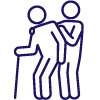- Yokohama-shi Top Page
- Konan Ward Top Page
- Introduction of the ward
- Overview of Konan Ward
- Origin of ward name
- The origin of the town name
The text is from here.
The origin of the town name
Last updated on August 1, 2024.
List of street names and origins of street names in Konan Ward
List of street names
Please see the list of street names.
The origin of the town name
It is a town newly established from each part of Okubo-cho, Kamiooka-cho, and Saido-cho with the enforcement of the house indication in 1975. It was transferred from the former Minami Ward following the reorganization of administrative districts on October 1, 1969. In the old days, it was called Kubo-mura, Kurakigun, and when the municipal system was enforced in 1889, it became Ooka Kawamura Oaza Kubo, and in 1927 it was transferred to Yokohama City to Okubocho. The street name was "Okubocho" because there was already Kubocho in Yokohama city, so it was covered with the word "large". Kunio Yanagida described in "Research on Place Names" in "Research on Place Names", "Kubo is very similar to Hodo from the topography, but it is a word (word) that works with Kuboi as an adjective and Kubom as an verb. It can also explain its meaning from modern language. " There is Aoki Shrine in 2-chome.
It is a town newly established from each part of Okubo-cho, Kamiooka-cho, and Sasashita-cho with the enforcement of the house indication in 1975. In the old days, it was called Kurakigun Kamiooka Village, and when the municipal system was enforced in 1889, Kubo Village, Saido Village, Bessho Village, Nakasato Village, Hiroaki Teramura, Shimo-Ooka Village, Makita Village, Horinouchi Village, Moving Village, Idoga Tanimura, and Nagata Village merged into Ooka Village and merged into Ooka City. In the old days, it was called "Oga-go", and was this changed to "Ooka"? Ookagawa flows on the west side, the Kamakura Highway passes through the center of 1-chome and 2-chome, and at 1-chome there is Keikyu Main Line, Kami-Ooka Station on the municipal subway, and Yumeooka Office Tower.
It is a town newly established from each part of Kamiooka-cho and Sasashita-cho with the enforcement of the house indication in 1975. The Keikyu Main Line runs through the west side of 2-chome. There is Kuraki Park in Sanchome (which spans Konan Ward and Isogo Ward) and Kamiooka Cemetery in Yokohama.
Please refer to "Kamiookanishi" for the origin of "Kamiooka".
With the enforcement of the house indication in 1979, it is a town newly established from each part of Kaminagaya, Shimonagaya, and Nobacho. Hirato Nagatanikawa flows through the center, and Loop No. 2 passes through the Yokohama Yokosuka Road through 1-chome and 3-chome, and the municipal underground railway passes through 5-chome and 6-chome. At 5-chome, there is Nagatani Tenmangu Shrine and Kaminagaya Fureai waterside.
Please refer to "Kaminagaya-cho" for the origin of "Kaminagaya".
This town was newly established from a part of Nagatani, Nagano Village, Kamakura-gun, when transferring to Yokohama City in 1936. It was transferred from the former Minami Ward following the reorganization of administrative districts on October 1, 1969. In the old days, it was called Nagatani Village, Kamakura-gun, and it was sometimes divided into Uemura Nagatani, Nagatani Nakamura, and Nagatani Shimomura. When the municipal system was enacted in 1889, it merged with Kami Noba Village, Shimo Noba Village and Hira Tomura Hiji to form Nagano Village Oaza Nagatani. It is said that "Nagaya" means "long valley" in place name research.
It is a town newly established from each part of Sasashita-cho, Kamiooka-cho, and Hino-cho with the enforcement of the house indication in 1972. In the old days, Kurakigun miscellaneous village, Matsumoto village, and Mimura of Sekimura, when the municipal system was enforced in 1889, Hino village, Yabe Nomura, Tanaka village, Kuriki village, Kaminakazato village, Minemura, Kooritori Sawamura merged into Hino village Oaza Sasashita 2 years, and merged into Shimoshita 1. The name of the town was "Konan", the name of the ward, at the request of the local community. "Muro no Kisaka", which is based on the character name "Muro no Ki", and "Sakuramichi", which is famous for its row of cherry trees, pass through. The Sasa Shimokawa (Ookagawa) flows through the east side of 4-chome, and the Sasashita Kamariya Road passes through.
It is a town newly established from each part of Hino-cho, Mine-cho, Isogo-ku, Kamigo-cho, Totsuka-ku, and Nakanomachi with the enforcement of the house indication in 1981. The name of the town was "Konandai", which was developed by the Japan Housing Corporation and used locally as a common name. The Yokohama Yokosuka Road passes on the northeast side, and the ring No. 3 passes on the south side. In addition, the JR Negishi Line passes through the center, and Konandai Station is located at Sanchome. In this area, there are many housing complex named birds such as Kamome housing complex and Hibari housing complex, and Konan Taihoku Park (Children's Log House Acorn House).
It is a town newly established from each part of Sasashita-cho, Kamiooka-cho, and Hino-cho with the enforcement of the house indication in 1972. In the old days, it was Mimura of Zoshiki Village, Matsumoto Village, and Sekimura, and was called Sasa Shimomura.When the municipal system was enforced in 1889, Hino Village, Yabe Nomura, Tanaka Village, Kuriki Village, Kaminakazato Village, Minemura, Kooritori Sawamura merged with Sasa-machi and Sasa-shi, Shimoshita 2. Since the name of the town is located in the center of the area, "Konan Chuo" was adopted at local request. The Hino River flows on the west side of the town, and the Sasa Shimokawa (Ookagawa) flows on the east side. The Kamakura Highway and Municipal Subway pass through the town, Konan Chuo Station, and government offices such as the Konan Ward Office and Konan police department are concentrated.
It is a town newly established from each part of Okubo-cho and Saido-cho with the enforcement of the house indication in 1975. In the old days, it was called Kuragi-gun (Kurakigun), and when the municipal system was enforced in 1889, Kubo-mura, Bessho-mura, Nakasatomura, Hiroaki Teramura, Kamiooka-mura, Makita-mura, Horinouchi-mura, moving village, Idoga Tanimura, and Nagata-mura merged into Ooka-mura, Ooka-mura and Ooka-mura. In the old days, it was said that "Shishido" or "Shishido" was written. According to Sumio Sakurai, "If the sound of the side is the original form, Saido can be considered. In other words, it is called "the place where the gods worship". The Ookagawa flows, and the Keikyu Main Line, the Municipal Subway, and the Kamakura Highway pass.
With the enforcement of the house indication in 1977, it is a town newly established from each part of Sasashita-cho, Morigaoka 2-chome, Isogo-ku, Tanakacho, and Morimachi. In the old days, it was called Sasa Shimomura in Kuragi-gun (Kurakigun) Shimosasashita (Miscellaneous Village, Matsumoto Village, Sekimura Shimogo Mimura), and was merged with Hino Village, Yabe Nomura, Tanaka Village, Kuriki Village, Kaminakazato Village, Minemura Hisasamura Kotori 9 and Sasamori. There is a theory that "Sasaki" was used as the place name, and this was later accented from "Sasagi Village" to "Sasa Shimomura". When Mr. Hiroyoshi Takeuchi built a castle here (Shino Shimojo), the place name of the ancestor's birthplace, Oomi-kuni Shino Bamboo Go, was named in this area when Mr. Mamiya built a castle here (Shino Shimo). It is said that this became "Sasashita". In the Buddhist temple bell casting of Bunroku (1592) at Tofukuji Temple in Sasa Shimogo-chome, "Sasashita Shikimura" is said to be the first appearance of the place name Sasashita. The Sasa Shimokawa (Ookagawa) flows through the center, and the Sasashita Kamariya Road passes through.
It is a town newly established from each part of Shimonagaya-cho, Kaminagaya 6-chome, and Kamikashio-cho, Totsuka-ku with the enforcement of the house indication in 1990. The name of the town was taken from Shimonagaya-cho. Shimonagaya-cho was newly established from a part of Nagatani, Nagano-mura, Kamakura-gun and a part of Hirato, Oaza, at the time of the transfer of Yokohama City in 1936. It was transferred from the former Minami Ward following the reorganization of administrative districts on October 1, 1969. It is said that "Nagaya" means "long valley" in place name research. Hirato Nagatanikawa flows on the west side of 1-chome and 2-chome, and Loop No. 2 passes.
It is a town newly established from a part of Shimonagaya-cho with the enforcement of the house indication in 1978. In the old days, it was called Nagatani Village, Kamakura-gun. When the municipal system was enacted in 1889, it merged with Kami Noba Village, Shimo Noba Village, and Hira Tomura Hiji to become Nagano Village Oaza Serigaya. In 1936, it was incorporated into Yokohama City and became Kaminagaya Town and Shimonagaya Town. It is said that "seri" means "cliff" in place name research.
This town was newly established in 1936 at the time of the transfer to Yokohama City, Nagano Village, Kamakura-gun, Kami Noba and Shimono Niwa. It was transferred from the former Minami Ward following the reorganization of administrative districts on October 1, 1969. In the old days, it was called Kami Noba Village and Shimo Noba Village. When the municipal system was enacted in 1889, it merged with Nagatani Village and Hira Tomura Hiji to form Nagano Village Oaza Kami Noba and Shimo Noba. In 1973, the Housing Supply Corporation Noba housing complex began to move in, and a huge housing complex was formed since then. The Yokohama Yokosuka Road passes through the town, and there is a municipal subway depot and the Yokohama Konan Library.
It is a town newly established from a part of Kaminagaya-cho and Shimonagaya-cho with the enforcement of house indications in 1978 and 1983. In the old days, it was called Nagatani Village, Kamakura-gun. When the municipal system was enacted in 1889, it merged with Kami Noba Village, Shimo Noba Village and Hira Tomura Hiji to become Nagano Village Oaza Nagatani. At the time of the transfer of Yokohama City in 1936, it became Kaminagaya Town and Shimonagaya Town. The Yokohama Yokosuka Road runs through Sanchome. It is said that "seri" means "cliff" in place name research.
It is a town newly established from a part of Kaminagaya-cho and Shimonagaya-cho with the enforcement of house indications in 1978 and 1983. In the old days, it was called Nagatani Village, Kamakura-gun. When the municipal system was enacted in 1889, it merged with Kami Noba Village, Shimo Noba Village and Hira Tomura Hiji to become Nagano Village Oaza Nagatani. At the time of the transfer of Yokohama City in 1936, it became Kaminagaya Town and Shimonagaya Town. The Yokohama Yokosuka Road runs through Sanchome.
This town was newly established from each part of Kaminagaya-cho, Shimonagaya-cho, Nobacho, and Maioka-cho, Totsuka-ku with the enforcement of the house indication in 1980. The name of the town was named after Fukutokuin Hiki guardian of children and travelers, which is enshrined at Hikiyama 1-chome. In the past, Kanji Iijima, who was engaged in agriculture, was usually suffering from a disease called tantrum. A monk who accidentally passed there was told that if he worshiped the limited guardian of children and travelers of Renkeiji Temple in Izu Mishima, the tantrum will be cured, and when he believed in this and prayed, he escaped from illness. It is said that he was able to do it. Based on this, in order to spread this merit to everyone, Renkeiji recommended the alter ego of guardian of children and travelers (a stone Buddha with a height of 2 feet and 4 inches, which is said to be one of the "Nippon Santai Jizo" along with the alter ego served in Yamanashi and Nagano) and served as the main deity of Fukutokuin. This temple was built on Mt. Yoshioka in Miyama Yutani, which was called "Mt. Koya-san in Yokohama" at the time. Initially, the temple was a single stand, but on July 1, 1953, it became the branch temple of Mt. Koya-san Shingon sect Kongomine-ji Temple. Every month, the day marked with "four" is said to be the anniversary of death, and it is said that if you pray for your wishes on this day, you will surely be fulfilled. January 4 of the New Year is the first fair, attracting many people from inside and outside Yokohama, and it is particularly lively. Municipal Subway passes through 1-chome and there is Shimonagaya Station.
It is a town newly established from a part of Hino-cho and Nobacho with the indication of the house in 1985. The Hino River flows on the east side, the Kamakura Highway passes, and the Yokohama Yokosuka Road passes through the border between 7-chome and 8-chome. Municipal Subways pass through 2-chome and 3-chome. There is Yokohama City Konan Sports Center in 1-chome.
It is a town newly established from a part of Hino Town with the indication of the house in 1993. In the old days, it was called Hinogo, and it was divided into four villages: Miyagaya Village, Miyanoshita Village, Kin Imura and Yoshiwara Village. At the time of the enforcement of the municipal system in 1889, Hino Township and Sasashita Township were combined and taken under "Sun" and "Sasashita" of "Hino" to become Kusaka Village. (Merged Hino Village, Sasa Shimomura, Yabe Nomura, Tanaka Village, Kuriki Village, Kaminakazato Village, Minemura, Kooritori Sawamura). Kusaka Village says "Hinoshitamura" in the notification of the Kanagawa Prefectural Gazette, which was enforced in 1889, but according to Hiroyoshi Takeuchi, Kusakamura first called "Kusakamura", but in the early days of Taisho, there were no people who read "Kusaka" and called "Hishimura". At the time of the transfer of Yokohama City on April 1, 1927, it became Hino-cho from Kurakigun, Kusakamura Oaza Hino character Motonomiya, Miyagaya, Miyanoshita, Kanai, Yoshiwara. The name of "Hino-cho" is the old village name. The current street name was taken from the previous street name "Hino-cho". The Kamakura Highway passes on the west side, the Hino River flows on the southwest side, the Yokohama Yokosuka Road passes, and the Hino Interchange is located at 2-chome. The municipal Hino Park Cemetery, which spreads over 1-chome, has a Sakuramichi Cherry Blossom Viewing Course.
It is a town newly established from Hino-cho and a part of Nobacho with the enforcement of house indications in 1983 and 1987. The name of the town is "Hinominami" because it is located on the south side of Hino Town. The Kamakura Highway passes through the center, the ring No. 3 passes through the border between 5-chome and 6-chome, Konan Recycling Plaza at 3-chome and Nobaen at 5-chome.
It is a town newly established from each part of Kaminagaya-cho and Nobacho with the enforcement of the house indication in 1979. The street name is the land readjustment district name in this area and the character name is taken. In front of the Yokohama Municipal Subway Kaminagaya Station, a monument to "New Town Maruyamadai" was erected in 1981 to commemorate the completion of the Konan Maruyama District Land Readjustment Project. Municipal Subway passes through 1-chome, and there is Kaminagaya Station.
Inquiries to this page
Konan Ward General Affairs Department Ward Administration Promotion Division
Phone: 045-847-8321
Phone: 045-847-8321
Fax: 045-846-2483
E-Mail address [email protected]
Page ID: 548-811-514












